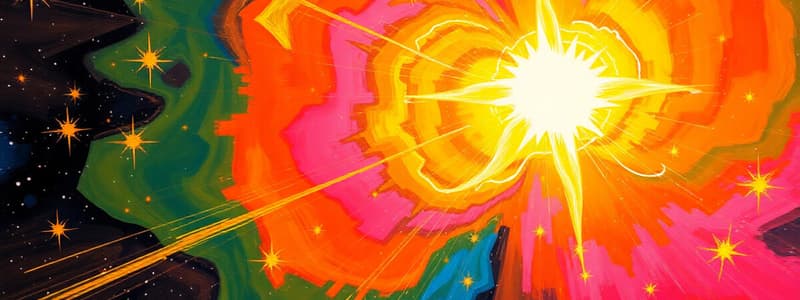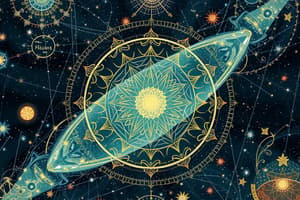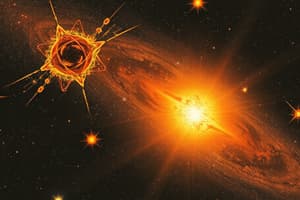Podcast
Questions and Answers
What triggers the thermal pulses in red supergiants?
What triggers the thermal pulses in red supergiants?
- Helium produced in the hydrogen shell dropping toward the center (correct)
- The formation of iron in the core
- The boiling of the star's outer layers
- The explosion of the star
Which characteristic is associated with Mira variable stars?
Which characteristic is associated with Mira variable stars?
- Long periods of over 100 days and amplitude greater than one magnitude (correct)
- Constant brightness without fluctuation
- Short periods and low amplitude
- Exclusively found in globular clusters
What is the period of Chi Cygni, a type of Mira variable star?
What is the period of Chi Cygni, a type of Mira variable star?
- 408 days (correct)
- 200 days
- 50 days
- 100 days
Which pulsating star is characterized by a period of 1.5 hours to several days?
Which pulsating star is characterized by a period of 1.5 hours to several days?
What process occurs during a thermal oscillation in stars with a mass less than 8 solar masses?
What process occurs during a thermal oscillation in stars with a mass less than 8 solar masses?
At what temperature does gravitational compression allow for carbon burning in massive stars?
At what temperature does gravitational compression allow for carbon burning in massive stars?
What is the final stage of stellar burning in massive stars, ending with the formation of iron?
What is the final stage of stellar burning in massive stars, ending with the formation of iron?
Why is no further energy extracted from fusing nuclei with iron?
Why is no further energy extracted from fusing nuclei with iron?
What primarily triggers the formation of new stars in interstellar space?
What primarily triggers the formation of new stars in interstellar space?
What is the primary role of dark nebulae in the birth of stars?
What is the primary role of dark nebulae in the birth of stars?
What factor causes a dark nebula to contract under its own gravity?
What factor causes a dark nebula to contract under its own gravity?
What do astrophysicists use to gather evidence about the existence of interstellar gas and dust?
What do astrophysicists use to gather evidence about the existence of interstellar gas and dust?
According to the Jeans Instability, what occurs in regions where density is slightly higher?
According to the Jeans Instability, what occurs in regions where density is slightly higher?
What does the Jeans Instability address in relation to the formation of stars?
What does the Jeans Instability address in relation to the formation of stars?
What is typically found in a dark nebula with respect to mass and volume?
What is typically found in a dark nebula with respect to mass and volume?
What is the typical temperature of dark nebulae that allows for star formation?
What is the typical temperature of dark nebulae that allows for star formation?
What initiates the process of hydrogen burning in a protostar?
What initiates the process of hydrogen burning in a protostar?
How does gravitational energy affect the formation of a star?
How does gravitational energy affect the formation of a star?
What is the role of pressure in the context of collapsing clouds?
What is the role of pressure in the context of collapsing clouds?
What is a characteristic feature of the pre-main sequence phase of a star?
What is a characteristic feature of the pre-main sequence phase of a star?
What happens to the temperature of a protostar during its contraction?
What happens to the temperature of a protostar during its contraction?
What happens when density perturbations grow in a collapsing cloud?
What happens when density perturbations grow in a collapsing cloud?
What does the Jeans length signify in the context of star formation?
What does the Jeans length signify in the context of star formation?
What triggers the end of contraction in the formation of a star?
What triggers the end of contraction in the formation of a star?
Flashcards
Star Formation
Star Formation
Process where stars are born from cold, dense clouds of interstellar gas and dust called dark nebulae
Jeans Instability
Jeans Instability
The collapse of a cloud under its own gravity due to a slight density fluctuation, leading to the formation of a star
Density Fluctuation
Density Fluctuation
The region where density is slightly higher in a cloud, attracts nearby material, leading to contraction and eventually star formation.
Gravitational Collapse
Gravitational Collapse
Signup and view all the flashcards
Dark Nebulae
Dark Nebulae
Signup and view all the flashcards
Hydrostatic Equilibrium
Hydrostatic Equilibrium
Signup and view all the flashcards
Protostar Formation
Protostar Formation
Signup and view all the flashcards
Nuclear Fusion Ignition
Nuclear Fusion Ignition
Signup and view all the flashcards
Gravity
Gravity
Signup and view all the flashcards
Gravitational Contraction
Gravitational Contraction
Signup and view all the flashcards
Free-Fall Time
Free-Fall Time
Signup and view all the flashcards
Sound Crossing Time
Sound Crossing Time
Signup and view all the flashcards
Jeans Length
Jeans Length
Signup and view all the flashcards
Protostar
Protostar
Signup and view all the flashcards
Mira Variable
Mira Variable
Signup and view all the flashcards
Stellar Pulsation
Stellar Pulsation
Signup and view all the flashcards
Cepheid Variable
Cepheid Variable
Signup and view all the flashcards
Stellar Death
Stellar Death
Signup and view all the flashcards
Supernova
Supernova
Signup and view all the flashcards
Neutron Star
Neutron Star
Signup and view all the flashcards
Pulsar
Pulsar
Signup and view all the flashcards
Black Hole
Black Hole
Signup and view all the flashcards
Study Notes
Introduction to Astronomy: Evolution of Stars
- Stars emit vast energy, implying they evolve.
- Human timescales are small compared to stellar lifetimes (millions to billions of years), making it seem like stars don't change.
- Stellar evolution theories combine observations and theoretical models.
- Stars form in interstellar gas clouds, mature, age, and die, enriching space for future generations.
Stellar Evolution: Contents
- Stellar Evolution (Introduction)
- Birth of Stars
- Stellar Maturity and old age
- Deaths of Stars
- Neutron stars and black holes
Stellar Evolution: Introduction
- Interstellar space contains tenuous matter (gas and dust).
- Observations like photographs, spectroscopy, and interstellar extinction show this matter.
- Stars form from cold, dark interstellar clouds (dark nebulae).
- Typical dark nebulae have thousands of solar masses of gas and dust spread over volumes of 10³pc³.
- These clouds have low temperatures (∼10K), causing contraction under their own gravity.
- Star formation is often triggered by nearby supernovae or galaxy collisions.
The Jeans Instability
- Newton's concept of density fluctuations in gases.
- Regions with slightly higher densities attract nearby material and gain mass (contraction).
- Increased pressure in these regions causes them to expand and disperse.
- Conditions for a density fluctuation to grow: the inward gravitational forces exceed outward pressure forces(a > b).
The Jeans Instability: Further Details
-
Consider a spherically symmetric mass distribution with density ρ and radius L.
-
Two important times are: (i) free-fall time (Tff) and (ii) sound wave crossing time (Ts), where Tff~ 1/√(Gp) and Ts~ L/Cs.
-
Density perturbations are damped if sound wave crossing time is shorter than the free-fall time (Ts < Tff).
-
Density perturbations grow if sound wave crossing time is longer than the free-fall time (Ts > Tff).
-
The Jeans length is the distance a fluctuation must extend to overcome opposition from pressure forces:
LJ = √(kT/mpGρ)
The Birth of Stars
- Gravitational energy transforms to thermal energy when a cloud contracts.
- Few thousands of years into contraction, the surface temperature reaches 2000-3000K.
- Protostar contraction continues, increasing the core temperature up to millions of degrees to begin hydrogen fusion.
- Once hydrogen burning begins, the pressure increases, arresting contraction.
- Stars with masses >60M☉ have too high a temperature that radiation pressure opposes contraction.
- Stars with masses <0.08M☉ do not reach the high temperature necessary for hydrogen fusion (brown dwarfs).
The Main Sequence
- Stars primarily spend their lifetimes in the main sequence, fusing hydrogen into helium.
- The core reaction of 4H → He + energy leads to a loss of mass: 0.048x10-27 kg.
- This mass is converted into energy according to Einstein's formula (E=mc2).
- The luminosity of a star is directly proportional to the mass raised to 3.5 power (L∝M3.5)
- This means that a high mass star has high luminosity, but a short lifetime.
Stellar Maturity: From Main Sequence to Red Giant
- As hydrogen decreases, the core has difficulty supporting the outer layers.
- The core contracts and heats up, increasing the temperature required to initiate hydrogen fusion in a shell around the core.
- Increasingly, the luminosity of the star increases.
- Outer layers expand and cool (red giant phase).
Stellar Maturity: Red Giant Evolution
- Helium core contracts, reaching temperatures for helium fusion (∼100 million K).
- Reactions produce heavier elements (e.g., Carbon, Oxygen).
- The energy released stops further core contraction.
- The time spent burning helium is 20% that of the main sequence period.
Stellar Maturity: Asymptotic Giant Branch
- Helium and hydrogen shell fusions power the Asymptotic Giant Branch (AGB).
- Helium produced in the outer hydrogen shell falls towards the star center.
- Thermal pulses in the helium shell cause periodic expansion and contraction of the star.
- Mira Variable stars are AGB stars that vary significantly in brightness (period>100 days).
Stellar Maturity: Other Pulsating Stars
- Cepheids are very luminous and massive stars with pulsation periods of 1-70 days.
- RR Lyrae stars are old population stars in globular clusters with periods of 1.5 hours to days, respectively.
- RV Tauri stars are yellow supergiants with periods of 20-100 days.
- Mira-type stars are pulsating AGB stars with periods of a few hundred days.
Stellar Death: Stars with 0.4 to 8 Solar Masses
- Stars with masses between 0.4 and 8 solar masses become white dwarfs after exhausting their nuclear fuel.
- The core is approximately the size of Earth and the mass of the sun.
- The core is supported by electron degeneracy pressure.
- The outer layers are blown away, forming a planetary nebula.
- Final product is a white dwarf.
Stellar Death: Stars with >8 Solar Masses
- Stars with masses greater than 8 solar masses are not supported by electron degeneracy pressure.
- The core collapses, leading to a significant increase in temperature.
- This increase initiates a series of nuclear reactions, releasing extreme energy.
- The star undergoes a supernova explosion.
- The remaining core collapses forming a neutron star or a black hole.
White Dwarf Observations
- Observations: Sirius A and B.
- Sirius B is a massive star (∼1.0 solar mass) with a radius of ∼4200 km.
- The surface temperature is 26000 K.
- Period of orbit = 50 years
More on white dwarfs
- White dwarfs vary in spectral type as their temperature decreases.
- The radius decreases with increasing mass. R ~ M−1/3
- The luminosity of a white dwarf decreases as it cools and gets older, possibly becoming "black dwarfs".
- White dwarf cooling timescales allow determination of age for globular clusters.
Other pulsating stars
Stellar Death: Neutron Stars
- Neutron stars are formed from the remnants of massive stars that have undergone supernova explosions.
- They have a radius around 10km.
- Supported by neutron degeneracy pressure.
- Strong magnetic fields (108 to 1015 times the Earth's field.)
- High rotational velocity—pulsars.
Stellar Death: Neutron Star: Crab Nebula
- Crab Nebula is a supernova remnant in Taurus.
- It resulted from a supernova documented by Chinese astronomers in 1054.
- It is located in the Perseus arm of the Milky Way, with a distance of 2 kiloparsecs (∼6500 light-years).
- Rotation of neutron star emits radiation that becomes energy in the nebula.
Black Holes
- Black holes are extremely dense regions in space with gravitational fields so strong that nothing, including light, can escape.
- They are described by Einstein's general relativity.
- The singularity forms the central point of a black hole.
- The event horizon marks the boundary from within which nothing can escape.
- Black holes result from the collapse of very massive stars.
- Black holes can have mass, angular momentum, and charge.
- There are techniques to measure these.
- Quantum processes can lead to black hole evaporation.
Stellar Evolution Summary Chart
- A visualization chart summarizing the different phases of stellar evolution based on mass, showing protostars, main sequence stars, red giants, white dwarfs, and neutron stars.
Studying That Suits You
Use AI to generate personalized quizzes and flashcards to suit your learning preferences.
Related Documents
Description
Test your knowledge on the intriguing phenomena of stellar pulsations and the processes involved in star formation. This quiz covers various types of variable stars, their characteristics, and the stages of stellar evolution leading to the birth of new stars. Dive into the fascinating world of astrophysics and enhance your understanding.




